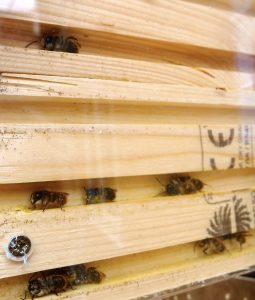Red mason bee (Osmia bicornis) males have home ranges when searching for females
Red mason bee male home range
Seidelmann states that Red Mason bee males, search for females within their own home ranges, in a non-aggressive manner towards other males. There is no need to be aggressive towards other males, as for example in a mating lek because as the females are not all found in one location but are scattered around a particular habitat using widely distributed resources, unlike the male wool carder bee, that defends his territory and aggressively attacks any flying insect that dares to enter.
What will a home range contain?
Each males patrols a home range, which can range between 3-30m2 and ideally, would contain suitable forage flowers, potential nest sites and hopefully virgin female bees. To a lesser extent, I have found mud can also attract males who cruise around in their quest to find a virgin female, who herself may be doing a recce of the area to find a mud source. This next ‘requirement’ made me laugh! Each home range had a sunspot for a little sunbathing! When one sunspot becomes overshadowed, the male would move to another area for a different sunspot. I quite like that idea!
Non-aggressive but certainly energetic!
However, I have seen males pounce upon, ambush, bump and crash mid-flight into other males and even mount other males in their quest to find a virgin female. Red mason females mate only once. Within home ranges, males would seek out virgin female and inspect flying insects, other bee species, insects or anything else that remotely resembled a female red mason bee. That includes a nesting queen Bombus pascuorum as I observed and shown in the film below. It would appear that the mating success of males depends primarily upon his ability to search for females at nesting sites or forage areas and to be the first to discover a virgin female. I have seen many males enter the emergence chamber of my nest boxes where numerous female bee cocoons are found still intact. Males also inspect nesting cavities. Once they find a suitable nesting site, many of them will use it to sleep and rest up during inclement weather, eagerly awaiting the females. I have seen 3 males mounting one female all at the same time, not quite a scramble competition polygyny which I have seen elsewhere where males form a seething mass ‘ball’ around one female bee.

Adaptive home ranges
Males can continuously alter their home ranges, adapting to changing circumstances such as plants starting to flower or virgin females emerging in a particular area. Such areas would become new home ranges and old home ranges, e.g. when the flowers had died out, would be abandoned. They would also, occasionally go exploring different areas probably as a recce for females, nest sites or potential new home ranges, then return to their home range.
Males may have spent days and days visiting my nest boxes, potential nesting sites or other nest boxes in gardens as well as other likely sites in his home range. I have noted over the years that sometimes several males come in small waves to the nest boxes, fly around, land on the boxes, pouncing and mounting, quick rest in the sun, patrolling an area, investigating ‘likely’ females and methodically investigating nest sites, nest entrances, emergence chambers, try their luck with nesting females as they return to their nest all creating short bursts of intense activity. Then they fly off.
The male in the film obviously had not read this research paper “Female choice in the red mason bee, Osmia rufa” as she had no choice whatsoever as she was unceremoniously dragged outside, fell onto the water butt lid and was immediately mounted whereby the male started his pre copulation display. According to Conrad, this comprises of the female selecting her mating male upon his performance when he vibrates his thorax, the length of time he performs the vibrations, a fitness test in reality and even the region he came from! Females prefer to mate with a male from the same region in this experiment.
Three phases of mating
Seidelmann states mating consists of three phases, pre-copulation courtship, copulation and postcopulatory embrace. I would like to add a fourth stage, drag her out of her natal nest!
This particular nest cavity had another 2 incidents which I filmed to show another time. It was completely untouched by me and left in situ all year on the off chance that I could film some behaviour or an incident I had not seen before. Many males visited it, when it contained the female cocoons, peeped inside or even crawled inside a short distance, whilst the females still slumbered deep inside the cavity all cocooned up.
Females of O. bicornis are monogamous as far as we know. They mate during the first few days after emergence (Seidelmann, 2014). Only the first male accepted by a female has a chance to copulate. This forces males to localize newly emerged females as soon as possible. There are no places where receptive females assemble, but nests from the previous year and food plants are possible. This is the first time I have seen a male enter a natal cavity to drag a female out.
Book _ Solitary Bees by Ted Benson
Interested in Citizen Science and pollinators? The Buzz Club
For more information about solitary bees visit BWARS
For info and link to buy an excellent book Field Guide to the Bees of Great Britain and Ireland by Steven Falk. An extremely useful resource supports this book by a special web site feature within Steve Falk’s Flickr web site which furnishes extra photos and other useful resources to assist with identification.

Great info. Is it possible to purchase a watchable bee hotel from you, please?
Email me please Mike, from my website -contact. thanks, George